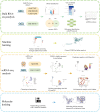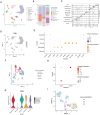Exploring the comorbidity mechanisms of ITGB2 in rheumatoid arthritis and membranous nephropathy through integrated bioinformatics analysis
- PMID: 40697036
- PMCID: PMC12288179
- DOI: 10.1080/0886022X.2025.2536730
Exploring the comorbidity mechanisms of ITGB2 in rheumatoid arthritis and membranous nephropathy through integrated bioinformatics analysis
Abstract
Background: Patients with rheumatoid arthritis (RA) are more likely to comorbid renal diseases, with membranous nephropathy (MN) being the most common. This study aimed to explore the common pathogenesis between RA and MN using integrated bioinformatics analysis.
Methods: Bulk and single-cell RNA sequencing datasets were obtained from the Gene Expression Omnibus and ImmPort databases. Differential expressed genes (DEGs) were identified and enrichment analysis was performed. Topology analysis and the random forest algorithm were applied to identify hub genes. The single-sample Gene Set Enrichment Analysis method was used to assess immune infiltration. Single-cell RNA sequencing analysis was employed to compare the transcript levels of key gene across different cell types. Pseudotime analysis was conducted using Monocle3, and cellular communication was analyzed with CellChat. The L1000FWD database was used to identify potential drugs, and molecular docking was performed.
Results: 66 common upregulated DEGs were identified, primarily associated with leukocyte migration and the chemokine signaling pathway. ITGB2 was finally identified as the shared pathogenic gene of both RA and MN. ITGB2 was predominantly expressed in macrophages, and its expression increased as M0 macrophages differentiated into M1 macrophages. BAFF signaling between macrophages with high ITGB2 expression and B cells/plasma cells was enhanced. Small molecules targeting ITGB2, including LY-294002 and CP466722, may serve as potential drugs for both RA and MN.
Conclusion: As the pathogenic gene shared by both RA and MN, ITGB2 may play a role in M1 macrophage polarization and contribute to the maturation and differentiation of B cells through BAFF signaling.
Keywords: B-cell activating factor; Rheumatoid arthritis; bioinformatics; machine learning; macrophage polarization; membranous nephropathy.
Conflict of interest statement
The authors declare that they have no competing interests
Figures








Similar articles
-
Identification of key genes in membranous nephropathy and non-alcoholic fatty liver disease by bioinformatics and machine learning.Front Immunol. 2025 Jun 5;16:1564288. doi: 10.3389/fimmu.2025.1564288. eCollection 2025. Front Immunol. 2025. PMID: 40539070 Free PMC article.
-
Identification of potential pathogenic genes associated with the comorbidity of rheumatoid arthritis and renal fibrosis using bioinformatics and machine learning.Sci Rep. 2025 Jul 1;15(1):21686. doi: 10.1038/s41598-025-05757-9. Sci Rep. 2025. PMID: 40596265 Free PMC article.
-
Machine learning and bioinformatics analysis to identify and validate diagnostic model associated with immune infiltration in rheumatoid arthritis.Clin Rheumatol. 2025 Jul;44(7):2683-2694. doi: 10.1007/s10067-025-07514-9. Epub 2025 Jun 11. Clin Rheumatol. 2025. PMID: 40500570
-
A systematic review of the effectiveness of adalimumab, etanercept and infliximab for the treatment of rheumatoid arthritis in adults and an economic evaluation of their cost-effectiveness.Health Technol Assess. 2006 Nov;10(42):iii-iv, xi-xiii, 1-229. doi: 10.3310/hta10420. Health Technol Assess. 2006. PMID: 17049139
-
Folic acid and folinic acid for reducing side effects in patients receiving methotrexate for rheumatoid arthritis.Cochrane Database Syst Rev. 2013 May 31;2013(5):CD000951. doi: 10.1002/14651858.CD000951.pub2. Cochrane Database Syst Rev. 2013. PMID: 23728635 Free PMC article.
References
MeSH terms
LinkOut - more resources
Full Text Sources
Other Literature Sources
Medical
Research Materials
Miscellaneous
